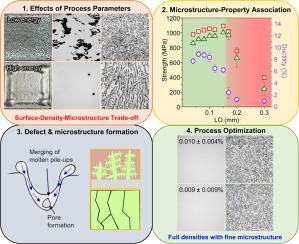Electron beam powder bed fusion of Ti–6Al–4V: Augmenting mechanical properties with low porosity and fine microstructure
IF 14.3
1区 材料科学
Q1 MATERIALS SCIENCE, MULTIDISCIPLINARY
引用次数: 0
Abstract
Electron beam powder bed fusion (PBF-EB) is a distinct class of additive manufacturing technique, capable of fabricating high-strength material, such as Ti–6Al–4V. Precise control of the process parameters plays a fundamental role in achieving the desired characteristics and process optimization has been extensively studied. However, discrepancies persist in the optimization of PBF-EB printed Ti–6Al–4V due to variations in machine configurations, study scopes, and parameter combinations. To address this issue, we herein investigate the individual effects of key parameters-scan speed, line offset, focus offset, and preheating temperature-on surface morphology, porosity, microstructure, and mechanical properties. While focus offset had a limited impact on the microstructure, increasing scan speed or line offset, thus decreasing the energy density, led to a refined microstructure and improved microhardness. However, excessive scan speed, line offset, or focus offset led to insufficient bonding, which compromised the tensile properties. In contrast, reducing scan speed and line offset, thus increasing the energy density, ensured sufficient fusion but yielded a coarse microstructure, which diminishes hardness and tensile strength. The lowest scan speed caused surface distortion and large spherical pores. These results culminated in a process map, which expounded the intricate relationships between the parameters in PBF-EB. These findings not only facilitated the optimization process to achieve fine microstructure and low porosity but may also serve as an anchoring framework for developing new material systems.

电子束粉末床熔合Ti-6Al-4V:提高低孔隙率和微结构的力学性能
电子束粉末床熔合(PBF-EB)是一种独特的增材制造技术,能够制造高强度材料,如Ti-6Al-4V。工艺参数的精确控制是实现理想特性的基础,工艺优化已被广泛研究。然而,由于机器配置、研究范围和参数组合的变化,PBF-EB印刷Ti-6Al-4V的优化存在差异。为了解决这一问题,本文研究了扫描速度、线偏移、焦点偏移和预热温度等关键参数对表面形貌、孔隙度、微观结构和力学性能的影响。虽然焦点偏移对微观组织的影响有限,但增加扫描速度或线偏移,从而降低能量密度,导致微观组织细化和显微硬度提高。然而,过大的扫描速度、线偏移或焦点偏移会导致键合不足,从而影响拉伸性能。相反,降低扫描速度和线偏移,从而增加能量密度,确保充分融合,但产生粗糙的组织,这降低了硬度和抗拉强度。较低的扫描速度导致表面畸变和较大的球形孔。这些结果最终形成了一个过程图,该过程图阐述了PBF-EB中参数之间的复杂关系。这些发现不仅促进了优化过程,以实现精细的微观结构和低孔隙率,而且可以作为开发新材料体系的锚定框架。
本文章由计算机程序翻译,如有差异,请以英文原文为准。
求助全文
约1分钟内获得全文
求助全文
来源期刊

Journal of Materials Science & Technology
工程技术-材料科学:综合
CiteScore
20.00
自引率
11.00%
发文量
995
审稿时长
13 days
期刊介绍:
Journal of Materials Science & Technology strives to promote global collaboration in the field of materials science and technology. It primarily publishes original research papers, invited review articles, letters, research notes, and summaries of scientific achievements. The journal covers a wide range of materials science and technology topics, including metallic materials, inorganic nonmetallic materials, and composite materials.
 求助内容:
求助内容: 应助结果提醒方式:
应助结果提醒方式:


